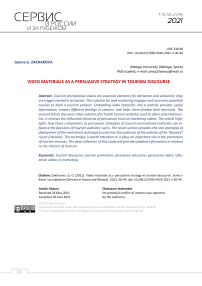Video materials as a persuasive strategy in tourism discourse
Автор: Zakharova Ganna G.
Журнал: Сервис в России и за рубежом @service-rusjournal
Рубрика: Теоретические аспекты экономики и туристского сервиса
Статья в выпуске: 2 (94), 2021 года.
Бесплатный доступ
Tourism promotional videos are essential elements for attraction and seduction; they are trigger elements to tourists. This solution for web marketing engages and convinces potential tourists to book a tourism product. Embedding video materials into a website provides useful information, creates different feelings in viewers, and helps them finalize their decisions. The present article discusses video solutions for health tourism websites used to allure potential tourists. It reviews the influential elements of persuasive tourism marketing videos. The article highlights how these components as persuasive strategies of tourism promotional materials can influence the decisions of tourism websites’ users. The result section provides the real examples of deployment of the mentioned technique to convince the audience of the website of the “Karpaty” resort (Ukraine). This technique is worth attention as it plays an important role in the promotion of tourism services. The data collection of this study will provide updated information in relation to the rhetoric of tourism.
Tourism discourse, tourism promotion, persuasive discourse, persuasive video, influential videos in marketing
Короткий адрес: https://sciup.org/140259950
IDR: 140259950 | DOI: 10.24412/1995-042X-2021-2-30-44
Список литературы Video materials as a persuasive strategy in tourism discourse
- Alvarez, M. D., & Campo, S. (2014). The influence of political conflicts on country image and intention to visit: A study of Israel's image. Tourism Management, 40, 70-78.
- Becken, S. (2010). The importance of climate and weather for tourism: Literature review. Retrieved from http://www.lincoln.ac.nz/PageFiles/6698/WeatherLitReview.pdf
- Bonney, E. K. (2014). The impact of advertising on consumer purchase decision. Available at: https://www.academia.edu/7809876/The_Impact_of_Advertising_on_Consumer_Pur-chase_Decision._A_Study_of_GIJ_Students_
- Cri§an, R. E., Bolyai, B., & Cantemir, D. (2013). Tourism destination slogans - persuasive or manipulative? Editura Universita^ii "Petru Maior". Retrieved September 10, 2020, from https://docplayer.net/20853214-Tourism-destination-slogans-persuasive-or-manipulative-key-words-metaphors-slogans-linguistics-the-language-of-tourism.html
- Cui, G., Liu, H., Yang, X., & Wang, H. (2013). Culture, cognitive style and consumer response to informational vs. transformational advertising among East Asians: Evidence from the PRC. Asia Pacific Business Review, 19(1), 16-31.
- Dimitrova, N., Hong-Jiang, Z., Behzad, S., Ibrahim, S., Thomas, H., & Avideh, Z. (2002). Applications of video-content analysis and retrieval. IEEE Multimedia, 42-55.
- Dirkin, K. H., Hilden, K., Koehler, M. J., Lundeberg, M. A., Phillips, M. M., & Yadav, A. (2011). If a Picture is Worth a Thousand Words is Video Worth A Million? Differences in Affective and Cognitive Processing of Video and Text Cases'. Journal of Computing in Higher Education, 23(1), 15-37.
- Hemsley-Brown, J., & Yaakop, A. (2014). Attitudes toward Specific Advertising Media (AM): Informative or Manipulative? Asian Social Science, 10(7). Canadian Centre of Science and Education.
- Jack, G., & Phipps, A. (2005). Tourism and Intercultural Exchange: Why Tourism Matters. Channel View Publications.
- Jorgensen, L. G. (2004). An analysis of a destination's image and the language of tourism. The Aarhus School of Business.
- Josiam, B. M., Kinley, T., Pookulangara, S., & Spears, D. L. (2012). Tourist see tourist do: The influence of Hollywood movies and television on tourism motivation and activity behavior. Hospitality Review, 30(1), 4.
- Kerckhove A., Pandelaere, M., & Tessitore, T. (2014). The amazing race to India: prominence in reality television affects destination image and travel intentions. Tourism management, 42, 3-12.
- Kim, H., & Fesenmaier, D. R. (2008). Persuasive design of destination web sites: An analysis of first impression. Journal of Travel Research, 47(1), 3-13.
- Kress, R. G., & Van Leeuwen T. (2006). Reading images: The grammar of visual design. London: Routledge.
- Lee, J., Pan, S., & Tsai, H. (2011). Framing New Zealand: Understanding tourism TV commercials. Tourism Management, 32, 596-603.
- Morgan, N., & Pitchard, A. (1998). Tourism Promotion and Power - Creating Images, Creating Identities. West Sussex: John Eiley & Sons Ltd.
- Salim, M. A. B., Ibrahim, N. A., & Hassan, H. (2012). Language for tourism: A review of literature. Procedia-Social and Behavioral Sciences, 62, 136-143.


